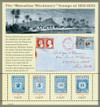
# 3694 - 2002 37c Hawaiian Missionaries, souvenir sheet of 4 stamps
37¢ Hawaiian Missionaries
City: New York, NY
Quantity: 1,610,000
Printed by: Banknote Corp of America
Printing Method: Lithographed
Perforations: 11
Color: Multicolored
The Hawaiian Missionaries
In 1819, Hawaiian King Kamehameha II established freedom of religion in the Islands. The American Board of Commissioners for Foreign Missions began sending teachers and missionaries to Hawaii. By the 1840s, many American missionaries had settled there.
To send a letter from Honolulu to America at that time, a person first had to find a ship ready to sail to the U.S. Then, he took his letter to the ship’s captain and asked him to mail it on the mainland. He did not pay the captain; the recipient would pay the postage. When he docked at a U.S. port, the captain took the letters to a post office, turned them in, and received two cents per letter for his service.
Incoming mail delivery was haphazard. Often mailbags were spilled across the counting table at a local business and people sorted through the stack looking for their mail.

As the volume of mail from missionaries, teachers, and traders increased, King Kamehameha III was asked to establish a more systematic arrangement for the mail. On June 18, 1851, the Legislature of the Kingdom of Hawaii authorized the printing of stamps of useful denominations.
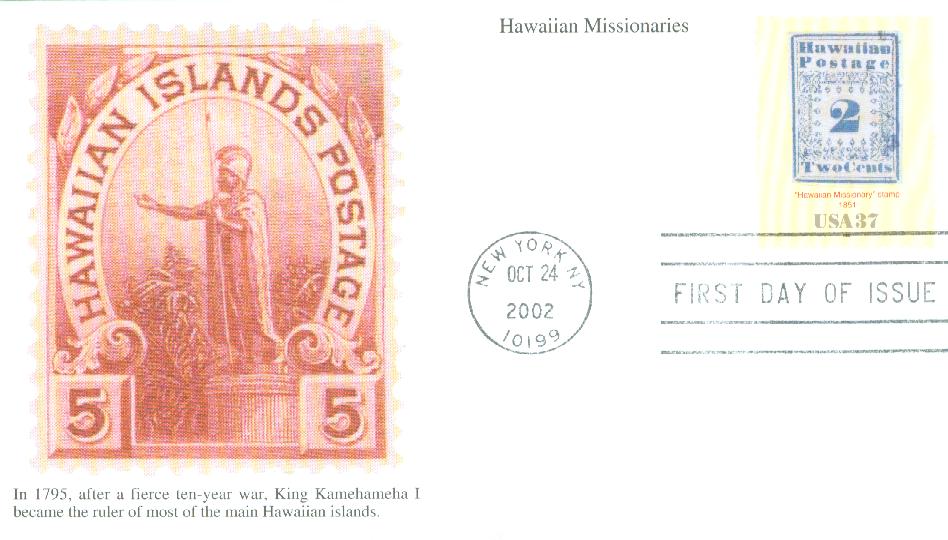
Postmaster Henry M. Whitney designed three denominations of postage stamps, using the same basic design. They were printed with loose, handset type on an old manual printing press brought over and assembled by early missionaries.

The first Hawaiian stamps, called “Missionaries,” were produced at the government printing office in Honolulu. Printed with blue ink on very thin paper, the stamps went on sale October 1, 1851.
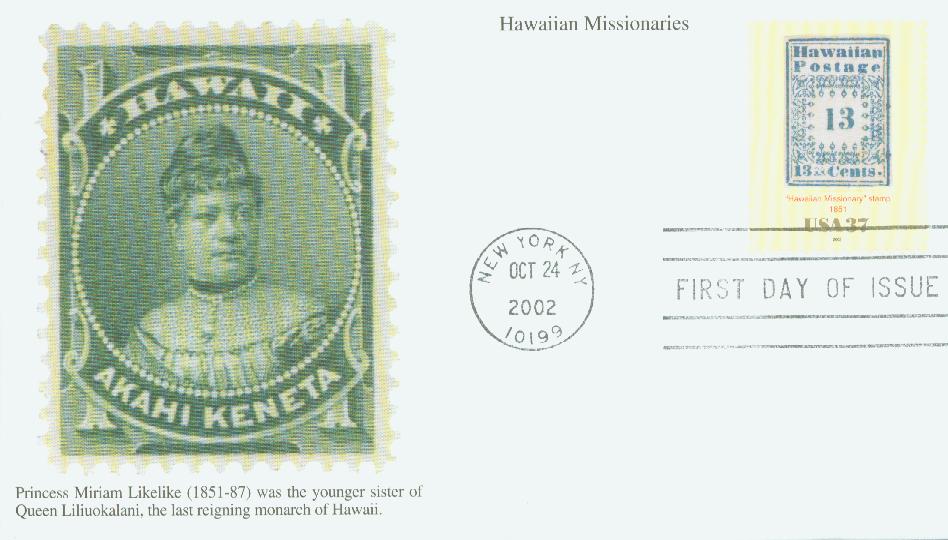
The 2-cent stamp paid the postage to the U.S. for newspapers and printed circulars. Since most newspaper wrappers were thrown away, few examples of the 2-cent stamp have survived.
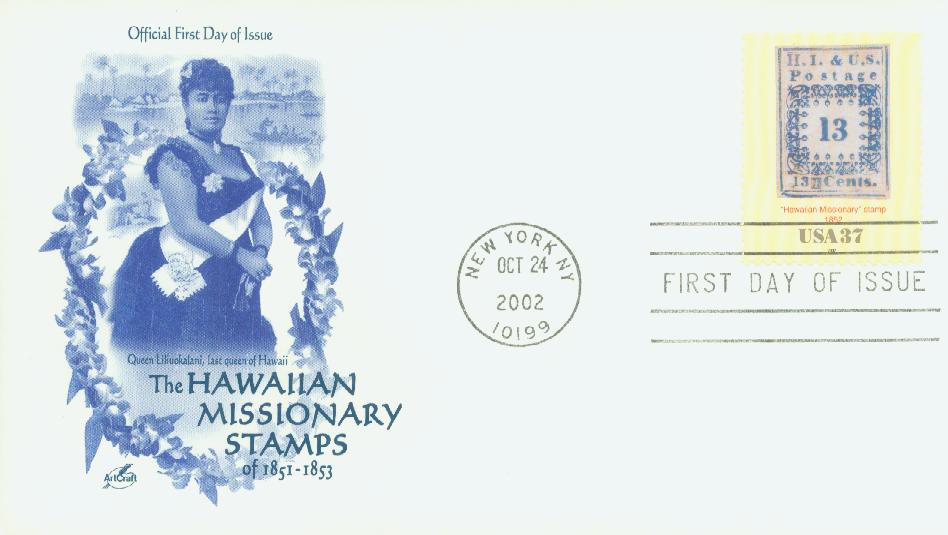
A 5-cent stamp was required to transport a letter from the Honolulu post office to a ship in the harbor. The 13-cent stamp paid the 5-cent Hawaiian postage to the ship, a 2-cent fee for the ship’s captain, plus the 6-cent U.S. postage from San Francisco to points east. To encourage literacy, letters sent to addressees within the Hawaiian Islands were delivered for free.
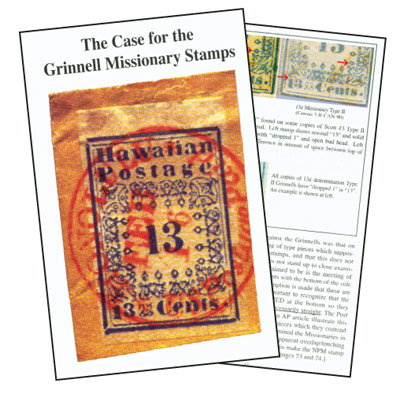
Sixty-seven years later, the Missionaries were at the center of a major controversy. In 1918, Los Angeles stamp collector George H. Grinnell claimed to have obtained a number of early Kingdom of Hawaii stamps. After he sold several of the stamps to a prominent collector, the collector claimed they were fakes and took Grinnell to court. Even though a judge ruled that they were forgeries, Grinnell spent the rest of his life trying to get the decision overturned. His family would later continue his crusade, though modern technology and further study would reveal that two of the stamps were likely genuine and the rest were forgeries.
| Click any of the First Day Covers above for more neat cover options for your collection. |
Click here to read more about the Grinnell Missionaries.
Click here to view more Hawaii stamps.
37¢ Hawaiian Missionaries
City: New York, NY
Quantity: 1,610,000
Printed by: Banknote Corp of America
Printing Method: Lithographed
Perforations: 11
Color: Multicolored
The Hawaiian Missionaries
In 1819, Hawaiian King Kamehameha II established freedom of religion in the Islands. The American Board of Commissioners for Foreign Missions began sending teachers and missionaries to Hawaii. By the 1840s, many American missionaries had settled there.
To send a letter from Honolulu to America at that time, a person first had to find a ship ready to sail to the U.S. Then, he took his letter to the ship’s captain and asked him to mail it on the mainland. He did not pay the captain; the recipient would pay the postage. When he docked at a U.S. port, the captain took the letters to a post office, turned them in, and received two cents per letter for his service.
Incoming mail delivery was haphazard. Often mailbags were spilled across the counting table at a local business and people sorted through the stack looking for their mail.

As the volume of mail from missionaries, teachers, and traders increased, King Kamehameha III was asked to establish a more systematic arrangement for the mail. On June 18, 1851, the Legislature of the Kingdom of Hawaii authorized the printing of stamps of useful denominations.

Postmaster Henry M. Whitney designed three denominations of postage stamps, using the same basic design. They were printed with loose, handset type on an old manual printing press brought over and assembled by early missionaries.

The first Hawaiian stamps, called “Missionaries,” were produced at the government printing office in Honolulu. Printed with blue ink on very thin paper, the stamps went on sale October 1, 1851.

The 2-cent stamp paid the postage to the U.S. for newspapers and printed circulars. Since most newspaper wrappers were thrown away, few examples of the 2-cent stamp have survived.

A 5-cent stamp was required to transport a letter from the Honolulu post office to a ship in the harbor. The 13-cent stamp paid the 5-cent Hawaiian postage to the ship, a 2-cent fee for the ship’s captain, plus the 6-cent U.S. postage from San Francisco to points east. To encourage literacy, letters sent to addressees within the Hawaiian Islands were delivered for free.

Sixty-seven years later, the Missionaries were at the center of a major controversy. In 1918, Los Angeles stamp collector George H. Grinnell claimed to have obtained a number of early Kingdom of Hawaii stamps. After he sold several of the stamps to a prominent collector, the collector claimed they were fakes and took Grinnell to court. Even though a judge ruled that they were forgeries, Grinnell spent the rest of his life trying to get the decision overturned. His family would later continue his crusade, though modern technology and further study would reveal that two of the stamps were likely genuine and the rest were forgeries.
| Click any of the First Day Covers above for more neat cover options for your collection. |
Click here to read more about the Grinnell Missionaries.
Click here to view more Hawaii stamps.



